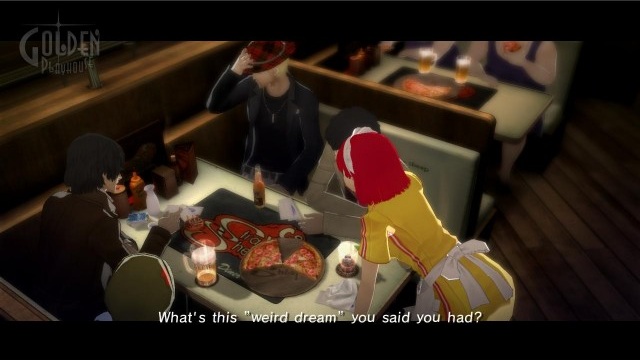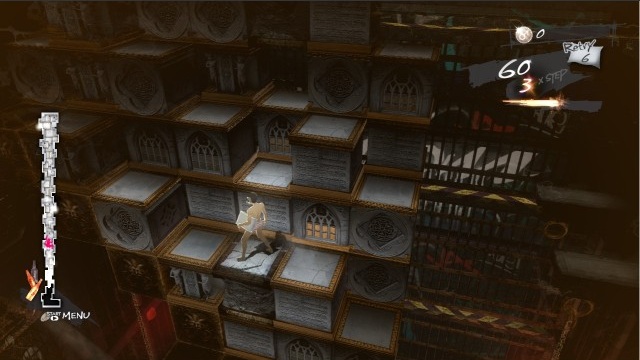"You think if Catherine lives, you won't wake up in the dark ever again to that awful screaming of the lambs." ~ Hannibal Lecter
Serendipitously, I have been playing Catherine while reading the contemporary novel A Personal Matter by Kenzaburō Ōe, winner of the 1994 Nobel Peace Prize for Literature. The comparison between the book and the video game is uncanny: Both frustrated, weak-willed modern-day male protagonists are in a stalled, flat relationship that is confronted by the immediacy of a pregnancy and the presence of another woman. Their lack of confidence and commitment leads them down a shaky path of cheating that only escalates the situation until they finally discover the resolve to make a decision. Sure, Catherine is a video game about ragingly difficult block puzzles, but its deliberate concoction of story and gameplay is forceful, seductive, and ultimately satisfying.
Vincent Brooks is the prototypical man on the cusp of middle-aged life, a slouchy manchild who breezed through his twenties without much concern and lives in a cramped, single, nameless apartment. On the white, black, and saccharine pink title screen, he, sheep-horned and bound half-naked by barbed wires to a suspended cube, seemingly calls out to his girlfriend Katherine, 32, who sits dispassionately to the side over his head. Sitting atop the link-chained menu, however, is the sudden temptress Catherine, 22, blond, bubbly, and demonically blessed: the same pronunciation with a candy twist. Thus is Vincent herded into a love triangle between marriage and sexual desire, to the gate-closing sound of a giant pendulum adorned with the astrological symbols of Venus and Mars—the ceaseless ticking of the biological clock.
The game's opening quotes Shakespeare: "All the world's a stage. And all the men and women merely players." But as the game suggests, it's only the men. Vincent's daily rest soon becomes haunted by nightmares where he and other men who appear as sheep must climb a towering wall of cubes before it crumbles before them. Chased by time and gargantuan bosses in the shape of their darkest fears, they ascend each cubic level to the chiming of a church bell—is it for a wedding or a funeral?—in the hope that they are not the next victims to plummet to their doom. It's a wicked and warped deviation of Intelligent Qube, if it were framed by a romantic thriller where falling in a dream means dying in real life and where no one remembers their collective nightmare, apart from dubious rumors and the depths of fatigue.
Puzzles are challenging, cruelly and notoriously, even on the Easy difficulty setting which gives players an abundance of retries almost in the sweet delight of watching the failure of mankind, like gods having a casual toast to the efforts of Sisyphus. The basic idea is to construct staircases by pushing and pulling cubes so that Vincent, with the panicked hops of Q*bert, can scale the wall and escape. But reaching the summit and basking in the heavenly light shining out of the exit door is hardly as simple as that: cubes can stack upon each other on merely their edges, enemies can block, push, and kill players, cubes come in many varieties (standard, heavy, immovable, trap, spring, bomb, ice, and even black hole), and almost every section requires players to recall at least one, if not seven, techniques. Just remember to pull out hair, not sanity.

Some levels can be unfair, particularly those with vindictively quick bosses or puzzles that require tricky maneuvering. The controls can sometimes get touchy when Vincent needs to turn around on a particular cube without wanting to move to the next block, or when he needs to hang along the edge of a block instead of moving down to an adjacent block. It gets even more finicky when the controls are reversed while Vincent wall-hangs around the back of the tower. But these instances are rare, and every level has checkpoints and is beatable with some speed, skill, and a little luck.
Meanwhile, Vincent must deal with his sense of powerlessness and vulnerability, and choose between the freedom of singlehood and the order of monogamous love (or neither). While roaming about the bar, aptly named "Stray Sheep", he can respond to text messages in ways that will pull him toward either Katherine or Catherine. The same goes for answering questions by costumers, other sheep, or a mysterious figure who speaks through a confessional and transports Vincent from one stage to the next. (Those connected online will see pie charts of how other players answered questions as well.) How Vincent is swayed determines the game's ending, of which there are eight, an encouraging number for masochistic completionists and fans of branching storylines.
What block puzzles have to do with romance relationships, though, is solely for waxing poetic. I suppose I could extrapolate some meaning, like the puzzles representing stairways to adolescence or the push and pull of love and hate, but it would only be obtuse straw-grabbing with the same desperation of a physics joke about dating. One is solved with spatial intelligence, the other with emotional intelligence. If there were a clear connection between the two, there would be no stereotype for nerds.

To strengthen the connection, the relationship meter could have had a more unmistakable influence, perhaps with players receiving particular items or encountering certain cube types depending on Vincent's romantic alignment. Without a firmer coupling between story and gameplay, the captivatingly eerie plot and cel-shaded graphics are merely window-dressing and palette-swapping, as spectacular as they are, around what is essentially a game about blocks.
This awkward disconnect segments the narrative from the puzzles, extending the already laborious first act, which drags on for three-fourths of the game. Until the climax of the revelation, Vincent repeats each day with the same timid, lackadaisical interest, deserving of the player's disdain and frustration. His pathetic complaining and indecision about his situation is exhausting, and it can make the first half of the game stifling to replay.
Thankfully, the Rapunzel mini-game and bonus challenge and competitive modes, albeit superfluous, offer welcome distractions from the main story. Players can also revisit levels to post high scores and win gold prizes to unlock extra content and earn well-deserved bragging rights.
Catherine should be commended for its courage to highlight not only two untapped genres, puzzle and adventure, but also combining them together into what can only be called a contemporary video game. Its mature themes, both sexual and religious, never step beyond the bounds of vulgarity and are treated respectfully and provocatively: It's actually mature. For that alone, and paving the way for a new modern hybrid of video games, Catherine should not be forgotten to the lamen silence of the lambs.
-
Challenging block puzzles
-
Mature, provocative, dark story
-
...that could be better integrated
-
Branching paths, multiple endings
-
Excellent cel-shaded graphics
-
Contemporary
-
Some control issues











